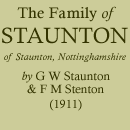Preface
When this work was first undertaken, I was so fortunate as to secure the assistance of Mr. F. M. Stenton, who is associated with the Victoria History of Nottinghamshire and other antiquarian works. He has kindly written the earlier pages of this essay, and given me advice and assistance with the remainder. I am convinced, however, that had he been sole author the ancient deeds would have been treated in a far more scholarly manner. It is to be hoped, therefore, that criticisms will not be aimed at him when they should more justly be directed at one whose only justification for engaging in a work of this nature lies in his deep and abiding interest in his birthplace and its history.
The Staunton deeds are some one thousand in number, and about nine hundred and thirty have been laid under contribution in this case. It is obvious, in a mass of documents like this, many of considerable interest could not be discussed in the space at our command. At the end of the 18th Century, Charles Mellish, of Blyth, laboriously copied and ably commented on the whole of the Staunton Manuscripts, and the results of his labours have been most kindly placed at the disposal of the joint authors by Mr. Mellish, of Hodsock Priory. Besides Mr. Mellish, thanks are also due to Mr. Arthur Wood, of Farndon, who first suggested the enterprise, and to the Editor of the Newark Advertiser, who published some of the material incorporated in this work.
Finally, it may be stated that the description of the more interesting of the Staunton muniments was undertaken in order that some permanent record might be preserved of a series of documents of great local interest. So far they have survived the perils of decay, fire, civil war, and possibly most dangerous of all, the carelessness of owners ignorant of their historic value; but fortune may not always prove so favourable. In any case, the labour spent over the investigation of these documents has provided many pleasant hours work to those by whom it was undertaken.
G. W. STAUNTON,
Kessingland, Suffolk. December, 1910.
